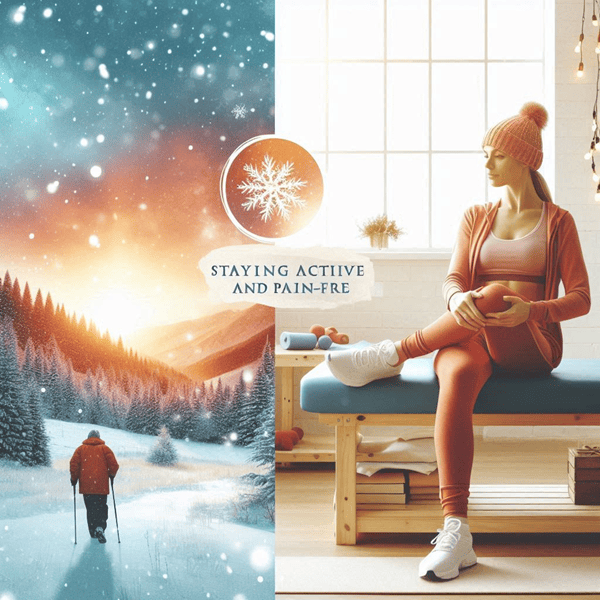Physiotherapy in Cold Seasons: Staying Active and Pain-Free in Winter
As the temperature drops and winter approaches, staying active and maintaining your physical health can become more challenging. Cold weather can bring about increased stiffness, joint pain, and even a higher risk of injury during exercise. However, with the right physiotherapy techniques and winter workout strategies, you can continue to stay fit and manage pain effectively. In this comprehensive guide, we will explore “Cold Weather Physiotherapy,” focusing on how to stay active and avoid injuries during the colder months.
In this article, we’ll cover essential tips for winter physical therapy, exercise in cold weather, cold season workouts, and much more. Whether you’re an avid winter sports enthusiast or just trying to maintain your fitness during the winter, this guide will provide expert advice on staying active safely.

Importance of Physiotherapy in Cold Seasons
Cold weather can have a profound impact on your muscles, joints, and overall physical health. As temperatures drop, your muscles tighten, blood circulation decreases, and joints become stiffer, which can lead to discomfort or injury if not addressed properly. Understanding how to adapt your exercise routine and incorporating physiotherapy techniques can be the key to staying active and pain-free.
Cold weather physiotherapy isn’t just for injury recovery—it’s also about maintaining mobility, preventing cold-weather injuries, and managing pain that’s exacerbated by the cold. It ensures that whether you’re exercising outdoors or transitioning to indoor workouts, your body stays healthy and resilient throughout the winter months.
Cold Weather Physiotherapy: Key Benefits
- Prevents Joint Stiffness and Muscle Tightness
Cold weather can cause muscles to contract and stiffen, leading to discomfort and a higher risk of strains and sprains. Regular physiotherapy can help keep muscles flexible and joints lubricated, ensuring better mobility during colder months. - Reduces Risk of Winter Injuries
Winter sports and activities like skiing, snowboarding, and even walking on icy paths increase the likelihood of injuries. Physiotherapy provides injury-prevention strategies, including warm-up exercises for winter and post-activity stretching routines. - Improves Circulation
In cold weather, reduced blood circulation can increase muscle stiffness and soreness. Physiotherapy techniques, including massage and stretching, can help improve circulation, keeping muscles warm and relaxed. - Manages Chronic Pain Conditions
For individuals suffering from arthritis or other chronic conditions, winter can worsen pain. Cold weather joint pain can be managed effectively through targeted physiotherapy programs.

Expertise in Cold Weather Physiotherapy
Why Cold Weather Affects the Body?
During cold months, your body naturally conserves heat by directing blood flow away from your extremities, which can lead to stiff muscles and joints. Muscles contract in response to the cold, becoming less flexible, while joints can become inflamed, making movement more painful. Additionally, cold weather lowers your core temperature, which may decrease your performance during exercise and increase the risk of injury if proper warm-up routines are not followed.
For those with chronic conditions like arthritis or fibromyalgia, the cold can exacerbate symptoms. The drop in barometric pressure, often associated with winter, can also contribute to increased joint pain.
Physiotherapy Techniques to Stay Active in Cold Weather
1. Warm-Up Exercises for Winter
A good warm-up is critical in cold weather to prepare your body for activity. Physiotherapists recommend dynamic warm-up exercises, such as:
- Leg swings: Improve hip flexibility.
- Arm circles: Loosen shoulder joints.
- Walking lunges: Engage major muscle groups and warm up your legs.
- Jumping jacks: Get your heart rate up and muscles warm.
These exercises help increase blood flow to muscles and reduce the risk of cold weather muscle stiffness. Aim for at least 10-15 minutes of dynamic warm-up exercises before starting your workout or outdoor activity.
2. Cold Weather Injury Prevention
Cold weather brings an increased risk of injuries, especially in outdoor activities such as skiing, ice skating, and snowboarding. Physiotherapists emphasize injury prevention strategies such as:
- Proper gear and footwear: Wearing shoes with good grip prevents slips on icy surfaces.
- Layering for outdoor exercise: Keeping muscles warm with proper clothing can reduce stiffness.
- Gradual cool-down: After exercising in the cold, gradually lowering your heart rate and stretching can prevent muscle tightness and stiffness.
3. Indoor Workouts for Winter
When the weather becomes too harsh for outdoor activities, you can still stay active with indoor exercises. Physiotherapists recommend a variety of winter rehabilitation exercises that can be done at home or in a gym:
- Resistance band exercises: Ideal for building strength in smaller spaces.
- Yoga and Pilates: Improve flexibility and core strength.
- Stationary cycling or treadmill: Maintain cardiovascular fitness indoors.
4. Managing Cold Weather Joint Pain
Cold weather can aggravate joint pain, especially in individuals with arthritis or joint injuries. Physiotherapy techniques to manage cold weather joint pain include:
- Hydrotherapy: Warm water therapy can help relieve joint stiffness.
- Therapeutic massage: Increases circulation and reduces inflammation in painful joints.
- Heat therapy: Applying heat packs to sore joints can improve flexibility and reduce pain.
Case Study: Winter Sports Injury Rehabilitation
Consider an avid skier who experiences a knee injury after a fall on icy terrain. Through winter sports physiotherapy, the physiotherapist designs a rehabilitation program focusing on:
- Strengthening exercises: To rebuild muscle around the knee joint.
- Balance training: To improve stability on uneven surfaces like snow.
- Range of motion exercises: To regain full movement in the injured joint.
By following a personalized physiotherapy regimen, the skier can recover more quickly and prevent future injuries.
Expert Opinions and Citations
Physiotherapists emphasize the importance of staying active year-round, even during colder months, to maintain joint and muscle health. According to research from the National Institute of Health, cold temperatures can lead to increased muscle tension and decreased flexibility, making proper warm-up routines essential.
Additionally, experts from the American Physical Therapy Association stress that cold weather physiotherapy can improve circulation, reduce the risk of injury, and help manage chronic conditions like arthritis during the winter months.
Renowned physiotherapist Dr. James O’Neill states, “Many people assume winter means a break from physical activity, but staying active is key to preventing stiffness and managing pain, especially for those with chronic conditions. Cold weather should not be an excuse to stop exercising but rather an opportunity to adapt your routine.”
For more information on managing winter fitness, the National Arthritis Foundation provides valuable resources on how to alleviate joint pain and stay active during colder months.
Practical Solutions and Safety Tips
Safety Considerations for Exercising in Cold Weather
Before engaging in outdoor activities, it’s important to follow cold weather exercise safety protocols to prevent hypothermia and frostbite:
- Dress in layers: Start with moisture-wicking materials to keep sweat away from your body, followed by insulating layers, and finish with a windproof jacket.
- Protect extremities: Wear gloves, a hat, and thermal socks to prevent heat loss from hands, feet, and head.
- Stay hydrated: Hydration in cold weather is often overlooked, but it’s essential to replace fluids lost during exercise.
- Be aware of icy conditions: Walking or running on icy paths increases the risk of slips and falls. Stick to cleared paths or consider indoor alternatives on icy days.
Indoor Workouts: Staying Fit When It’s Too Cold Outside
For those who prefer indoor workouts during the winter, staying consistent with winter exercise routines is key. Create a home workout routine that incorporates:
- Bodyweight exercises: Push-ups, squats, and planks require no equipment but are effective for maintaining strength.
- Resistance training: Using resistance bands or dumbbells can help maintain muscle tone.
- Cardio: Jump rope, indoor cycling, or following an online aerobic class can keep your heart rate up even when it’s too cold outside.


